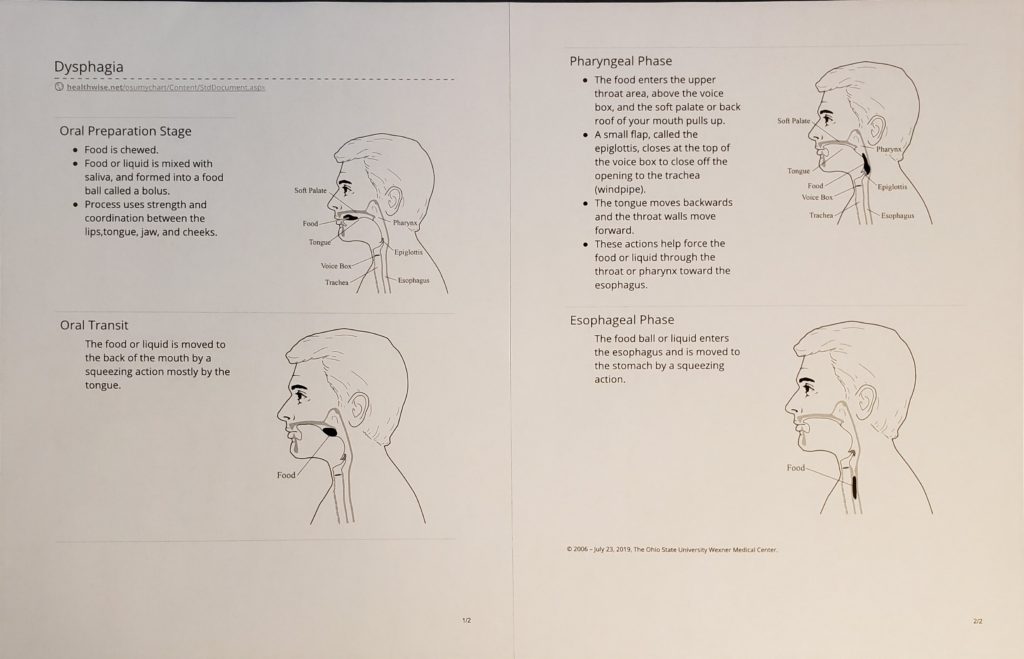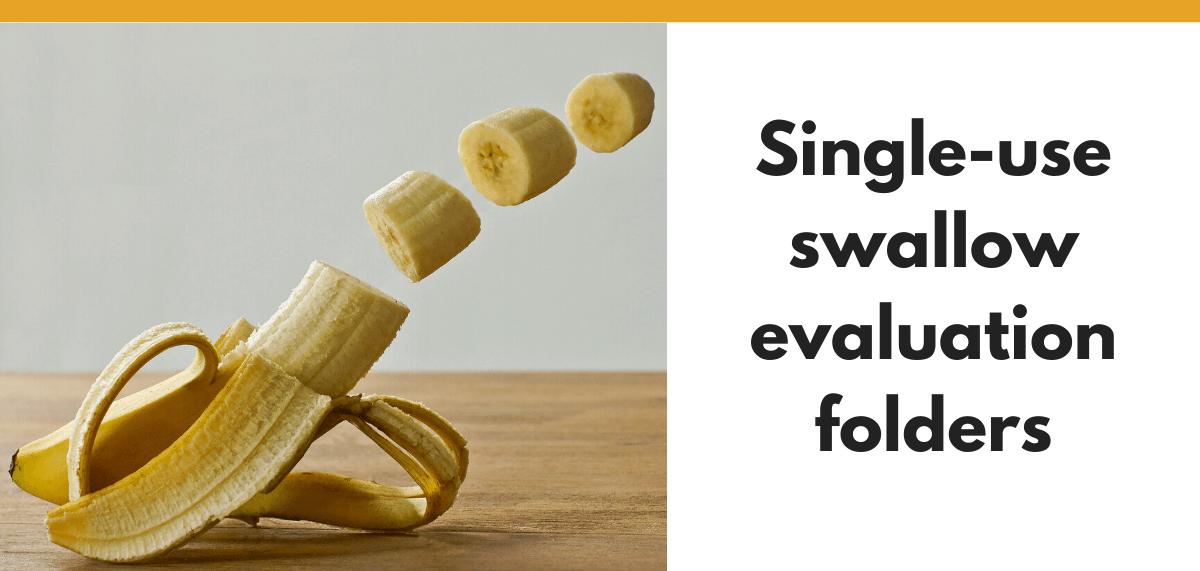Gone are the days of carrying a small library of materials into patients’ homes. Here’s how I’m making and using single-use swallow evaluation folders.
Free DIRECT download: Having trouble swallowing? (patient handout). (Email subscribers get free access to all the resources in the Free Subscription Library.)
Outline:
- Making single-use swallow evaluation folders.
- Tips for using single use evaluation folders.
- Contents of a single-use swallow evaluation folder.
- Your agency forms.
- EAT-10.
- Oral hygiene brochure.
- Reflux Symptom Index.
- IDDSI’s patient handout(s).
- General dysphagia education handout.
- Four phases of swallowing handout.
- Related Eat, Speak, & Think posts.
- Which swallowing handouts do you use often?
Making single-use swallow evaluation folders
Due to COVID-19, we’re all in a situation where we can’t carry our work bags into at least some patients’ homes or rooms. But we still have to do standardized tests, and we need to be prepared to offer education and counseling. One solution is to carefully select the most relevant testing and education materials to bring with you, and plan to leave it there.
Here are my tips for making single-use evaluation folders:
- Make copies of the forms and handouts you use most often for swallowing.
- Put one copy of each into a manila file folder.
- Repeat for as many folders as you think you’ll need for a week or two.
- Adjust the contents after a week or two of using them.
I’m using the standard manila file folders*, but you can also simply staple or paperclip the stack of papers together. I like using some sort of folder because it helps keep my patient organized. It also makes it more likely that we can find the materials during follow-up sessions.

When I’m working with someone who I predict will end up with a lot of handouts from me, which often happens for language or cognitive therapy, I’ll use folders with pockets*.

*This is an Amazon affiliate link. As an Amazon associate, I may
earn a small commission on qualifying purchases. There is no extra
charge to you, and it will help keep Eat, Speak, & Think
sustainable.
Tips for using single-use evaluation folders
- When you schedule a swallow evaluation, tweak the contents based on your chart review and discussion with the patient or family.
- Take the folder into the patient’s house or room, and leave it there.
- Throw away anything that isn’t relevant.
- Tell the patient to leave papers you haven’t taught yet in the folder for future therapy sessions.
What do we do with the questionnaires that patients touch? It depends on the level of precaution you’re following, which is determined by your employer. But in general, you probably won’t carry out paperwork if coronavirus may be present.
Here are some options after they fill out the questionnaire.
- Document their score in the EMR during the visit.
- Jot down their score on paper we keep in our pocket.
- Snap a picture of their form without capturing identifying information
- Rely on our memory.
- If you’re not carrying anything, pull up the questionnaire on your phone and ask the questions.
What if we don’t have something that we need?
- Teach what we remember and write down the key points.
- Look for the information online (such as on this website).
- Offer to email additional resources before the next visit.
- Run out to our vehicle, if it’s there and if it really can’t wait until the next visit.
Contents of a single-use swallow evaluation folder
This is what I’m currently carrying in my swallow evaluation folders.
- The forms my agency requires.
- EAT-10.
- Oral hygiene brochure.
- Reflux Symptom Index.
- IDDSI‘s Level 6 Soft & Bite-sized example foods.
- Trouble eating or drinking? (Patient handout).
- Four phases of swallowing handout.
The oral hygiene brochure is an excellent resource from Theresa Richard’s Medical SLP Collective.
You can easily find the Reflux Symptom Index with a quick online search. I don’t think I can share it directly.
IDDSI offers great patient education handouts. The Level 6 Soft & Bite-sized example foods handout is the one I’m most likely to need during an evaluation. The education and training I do with modifying foods or liquids generally comes on subsequent visits, after I’ve obtained instrumental data.
Four phases of swallowing handout
Regarding the swallow anatomy education sheet, I spent a long time trying to find a free one that I could link to. Although I couldn’t find one, I did figure out an easy way to get a great two-page handout. I can’t share my copy directly, due to copyright, but I can tell you how to make your own.

Here’s how you can quickly get a PDF of the two-page handout.
- Pull up Wexner Medical Center’s dysphagia education page.
- Copy the URL, paste it into printfriendly.com, and click on “Preview.”
- In the menu above the document, select “70%” for text and “75%” for images.
- Hover your mouse over each text box that you don’t want and click on the trashcan to delete it.
- I deleted everything except for the four phases and the copyright line for my handout.
And now you know how to turn just about any page on the internet into a PDF!
Related Eat, Speak, & Think posts
- 9 free swallow assessment tools.
- 10 factors that increase risk of aspiration pneumonia.
- Single-use communication evaluation folders.
- Single-use cognitive evaluation folders.
- Take the guesswork out of thickening liquids with the IDDSI flow test.
- A practical guide to pureed food at home.
Which swallowing handouts do you use often?
I’m always looking for great new resources to share with my patients. Please share below, or contact me directly.
Free DIRECT download: Having trouble swallowing? (patient handout). (Email subscribers get free access to all the resources in the Free Subscription Library.)
Lisa earned her M.A. in Speech-Language Pathology from the University of Maryland, College Park and her M.A. in Linguistics from the University of California, San Diego.
She participated in research studies with the National Institute on Deafness and other Communication Disorders (NIDCD) and the University of Maryland in the areas of aphasia, Parkinson’s Disease, epilepsy, and fluency disorders.
Lisa has been working as a medical speech-language pathologist since 2008. She has a strong passion for evidence-based assessment and therapy, having earned five ASHA Awards for Professional Participation in Continuing Education.
She launched EatSpeakThink.com in June 2018 to help other clinicians be more successful working in home health, as well as to provide strategies and resources to people living with problems eating, speaking, or thinking.



Be First to Comment